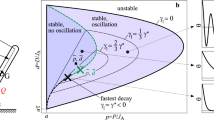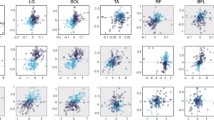Abstract
This article investigates the human postural regulation problem from the dynamical system perspective, which is also applicable for human-like robotics. More precisely, since the dynamical human posture parameters may change caused by varying load or environment abrupt, the semi-Markov jump process is employed to model the human standing postural dynamics with multiple modes. Furthermore, a novel memorized regulation strategy is developed for guaranteeing the stable standing such that the past memory information can be well utilized. In particular, the asynchronous regulation procedure is considered for better describing the human postural model with mismatched jumping modes. By model transformation and stochastic analysis, mode-dependent regulation criteria with state feedback model are established by convex optimization approach, based on which the mode-dependent regulation gains are designed accordingly. Finally, the feasibility and effectiveness of our proposed regulation strategy is verified via an illustrative example of quiet upright standing posture.
Similar content being viewed by others
References
Z. Zhang, J. Zhao, H. Chen, and D. Chen, “A survey of bioinspired jumping robot: takeoff, air posture adjustment, and landing buffer,” Applied Bionics and Biomechanics, vol. 2017, Article ID 4780160, 2017.
Q. Wu, C. Liu, J. Zhang, and Q. Chen, “Survey of locomotion control of legged robots inspired by biological concept,” Science in China Series F: Information Sciences, vol. 52, no. 10, pp. 1715–1729, 2009.
T. George Thuruthel, Y. Ansari, E. Falotico, and C. Laschi, “Control strategies for soft robotic manipulators: A survey,” Soft Robotics, vol. 5, no. 2, pp. 149–163, 2018.
I. Maroger, N. Ramuzat, O. Stasse, and B. Watier, “Human trajectory prediction model and its coupling with a walking pattern generator of a humanoid robot,” IEEE Robotics and Automation Letters, vol. 6, no. 4, pp. 6361–6369, 2021.
M. J. Gielniak, C. K. Liu, and A. L. Thomaz, “Generating human-like motion for robots,” The International Journal of Robotics Research, vol. 32, no. 11, pp. 1275–1301, 2013.
S. Hasan and A. K. Dhingra, “An adaptive controller for human lower extremity exoskeleton robot,” Microsystem Technologies, vol. 27, no. 7, pp. 2829–2846, 2021.
H. S. Lo and S. Q. Xie, “Exoskeleton robots for upper-limb rehabilitation: State of the art and future prospects,” Medical Engineering & Physics, vol. 34, no. 3, pp. 261–268, 2012.
D. Shi, W. Zhang, W. Zhang, L. Ju, and X. Ding, “Human-centred adaptive control of lower limb rehabilitation robot based on human-robot interaction dynamic model,” Mechanism and Machine Theory, vol. 162, 104340, 2021.
H. Vallery, J. Veneman, E. Van Asseldonk, R. Ekke-lenkamp, M. Buss, and H. Van Der Kooij, “Compliant actuation of rehabilitation robots,” IEEE Robotics & Automation Magazine, vol. 15, no. 3, pp. 60–69, 2008.
H. Shirzadfar, “The structure and function of nervous system and skeletal muscle: A review,” Current Neuropsychiatry and Clinical Neuroscience Reports, vol. 3, no. 1, pp. 1–25, 2021.
O. R. Langworthy, “The control of posture by the central nervous system,” Physiological Reviews, vol. 8, no. 2, pp. 151–190, 1928.
S. Zill, J. Schmitz, and A. Büschges, “Load sensing and control of posture and locomotion,” Arthropod Structure & Development, vol. 33, no. 3, pp. 273–286, 2004.
Y. P. Ivanenko, R. E. Poppele, and F. Lacquaniti, “Motor control programs and walking,” The Neuroscientist, vol. 12, no. 4, pp. 339–348, 2006.
R. D. Trumbower and C. Tuthill, “Neural regulation of whole limb impedance: from measurements to mechanisms,” Current Opinion in Physiology, vol. 22, 100437, 2021.
K. Radkhah, C. Maufroy, M. Maus, D. Scholz, A. Seyfarth, and O. Von Stryk, “Concept and design of the biobiped1 robot for human-like walking and running,” International Journal of Humanoid Robotics, vol. 8, no. 03, pp. 439–458, 2011.
D. Tlalolini, C. Chevallereau, and Y. Aoustin, “Humanlike walking: Optimal motion of a bipedal robot with toe-rotation motion,” IEEE/ASME Transactions on Mechatronics, vol. 16, no. 2, pp. 310–320, 2010.
F. H. Petzschner, S. N. Garfinkel, M. P. Paulus, C. Koch, and S. S. Khalsa, “Computational models of interoception and body regulation,” Trends in Neurosciences, vol. 44, no. 1, pp. 63–76, 2021.
L. Zollo, L. Rossini, M. Bravi, G. Magrone, S. Sterzi, and E. Guglielmelli, “Quantitative evaluation of upper-limb motor control in robot-aided rehabilitation,” Medical & Biological Engineering & Computing, vol. 49, no. 10, pp. 1131–1144, 2011.
S. Kumar, N. Patel, and L. Behera, “Visual motor control of a 7 DOF robot manipulator using function decomposition and sub-clustering in configuration space,” Neural Processing Letters, vol. 28, no. 1, pp. 17–33, 2008.
S. Li, H. Wang, and S. Zhang, “Human-robot collaborative manipulation with the suppression of human-caused disturbance,” Journal of Intelligent & Robotic Systems, vol. 102, no. 4, pp. 1–11, 2021.
A. Ishida, T. Masuda, H. Inaoka, and Y. Fukuoka, “Stability of the human upright stance depending on the frequency of external disturbances,” Medical & biological engineering & computing, vol. 46, no. 3, pp. 213–221, 2008.
J. R. Chagdes, S. Rietdyk, M. H. Jeffrey, N. Z. Howard, and A. Raman, “Dynamic stability of a human standing on a balance board,” Journal of Biomechanics, vol. 46, no. 15, pp. 2593–2602, 2013.
S. P. Silfies, A. Bhattacharya, S. Biely, S. S. Smith, and S. Giszter, “Trunk control during standing reach: A dynamical system analysis of movement strategies in patients with mechanical low back pain,” Gait & Posture, vol. 29, no. 3, pp. 370–376, 2009.
J. R. Chagdes, S. Rietdyk, J. M. Haddad, H. N. Zelaznik, M. E. Cinelli, L. T. Denomme, K. C. Powers, and A. Raman, “Limit cycle oscillations in standing human posture,” Journal of Biomechanics, vol. 49, no. 7, pp. 1170–1179, 2016.
H. Hemami and A. Katbab, “Constrained inverted pendulum model for evaluating upright postural stability,” Journal of Dynamic Systems, Measurement, and Control, vol. 104, pp. 343–349, 1982.
P. Gawthrop, I. Loram, and M. Lakie, “Predictive feedback in human simulated pendulum balancing,” Biological Cybernetics, vol. 101, no. 2, pp. 131–146, 2009.
A. D. Kuo, “An optimal control model for analyzing human postural balance,” IEEE Transactions on Biomedical Engineering, vol. 42, no. 1, pp. 87–101, 1995.
Z. Zheng, F. Mo, T. Liu, and X. Li, “A novel neuromuscular head-neck model and its application on impact analysis,” IEEE Transactions on Neural Systems and Rehabilitation Engineering, vol. 29, pp. 1394–1402, 2021.
P. Gawthrop, I. Loram, H. Gollee, and M. Lakie, “Intermittent control models of human standing: similarities and differences,” Biological Cybernetics, vol. 108, no. 2, pp. 159–168, 2014.
H. Wang and A. J. van den Bogert, “Identification of postural controllers in human standing balance,” Journal of Biomechanical Engineering, vol. 143, no. 4, 041001, 2021.
P. Shi and F. Li, “A survey on Markovian jump systems: Modeling and design,” International Journal of Control, Automation, and Systems, vol. 13, no. 1, pp. 1–16, 2015.
A. R. Teel, A. Subbaraman, and A. Sferlazza, “Stability analysis for stochastic hybrid systems: A survey,” Automatica, vol. 50, no. 10, pp. 2435–2456, 2014.
P. Zhao, Y. Kang, and Y. Zhao, “A brief tutorial and survey on markovian jump systems: Stability and control,” IEEE Systems, Man, and Cybernetics Magazine, vol. 5, no. 2, pp. 37–C3, 2019.
Y. Jin, W. Qi, and G. Zong, “Finite-time synchronization of delayed semi-markov neural networks with dynamic event-triggered scheme,” International Journal of Control, Automation, and Systems, vol. 19, no. 6, pp. 2297–2308, 2021.
K. Yin, D. Yang, J. Liu, and H. Li, “Asynchronous control for positive markov jump systems,” International Journal of Control, Automation, and Systems, vol. 19, no. 2, pp. 646–654, 2021.
Z. Wu, P. Shi, Z. Shu, H. Su, and R. Lu, “Passivity-based asynchronous control for markov jump systems,” IEEE Transactions on Automatic Control, vol. 62, no. 4, pp. 2020–2025, 2016.
Z. Wu, S. Dong, H. Su, and C. Li, “Asynchronous dissipative control for fuzzy markov jump systems,” IEEE transactions on cybernetics, vol. 48, no. 8, pp. 2426–2436, 2017.
S. Dong, Z. Wu, Y. Pan, H. Su, and Y. Liu, “Hidden-markov-model-based asynchronous filter design of nonlinear markov jump systems in continuous-time domain,” IEEE Transactions on Cybernetics, vol. 49, no. 6, pp. 2294–2304, 2018.
P. Cheng, M. Chen, V. Stojanovic, and S. He, “Asynchronous fault detection filtering for piecewise homogenous markov jump linear systems via a dual hidden markov model,” Mechanical Systems and Signal Processing, vol. 151, 107353, 2021.
H. Shen, M. Chen, Z. Wu, J. Cao, and J. H. Park, “Reliable event-triggered asynchronous extended passive control for semi-markov jump fuzzy systems and its application,” IEEE Transactions on Fuzzy Systems, vol. 28, no. 8, pp. 1708–1722, 2019.
H. Qiao, J. Chen, and X. Huang, “A survey of brain-inspired intelligent robots: Integration of vision, decision, motion control, and musculoskeletal systems,” IEEE Transactions on Cybernetics, vol. 52, no. 10, pp. 11267–11280, 2022.
M. Wang, J. Qiu, and G. Feng, “Finite frequency memory output feedback controller design for discrete-time systems with state multiplicative noises,” Asian Journal of Control, vol. 24, no. 2, pp. 997–1001, 2022.
L. Xie, J. Cheng, H. Wang, J. Wang, M. Hu, and Z. Zhou, “Memory-based event-triggered asynchronous control for semi-markov switching systems,” Applied Mathematics and Computation, vol. 415, 126694, 2022.
Y. Zhang and X. Mu, “Event-triggered output quantized control of discrete markovian singular systems,” Automatica, vol. 135, 109992, 2022.
Y. Zhang, P. Shi, R. K. Agarwal, and Y. Shi, “Event-based mixed H and passive filtering for discrete singular stochastic systems,” International Journal of Control, vol. 93, no. 10, pp. 2407–2415, 2020.
Y. Zhang, P. Shi, and M. V. Basin, “Event-based finite-time H filtering of discrete-time singular jump network systems,” International Journal of Robust and Nonlinear Control, vol. 32, no. 6, pp. 4038–4054, 2022.
Y. Zhang, P. Shi, R. K. Agarwal, and Y. Shi, “Event-based dissipative analysis for discrete time-delay singular jump neural networks,” IEEE Transactions on Neural Networks and Learning Systems, vol. 31, no. 4, pp. 1232–1241, 2020.
P. Gawthrop, I. Loram, M. Lakie, and H. Gollee, “Intermittent control: a computational theory of human control,” Biological Cybernetics, vol. 104, no. 1, pp. 31–51, 2011.
A. J. van der Schaft and A. van der Schaft, L2-gain and Passivity Techniques in Nonlinear Control, Springer, vol. 2, 2000.
J. Cheng, C. K. Ahn, H. R. Karimi, J. Cao, and W. Qi, “An event-based asynchronous approach to Markov jump systems with hidden mode detections and missing measurements,” IEEE Transactions on Systems, Man, and Cybernetics: Systems, vol. 49, no. 9, pp. 1749–1758, 2018.
R. J. Peterka, “Postural control model interpretation of stabilogram diffusion analysis,” Biological Cybernetics, vol. 82, no. 4, pp. 335–343, 2000.
Author information
Authors and Affiliations
Corresponding author
Ethics declarations
The authors declare that there is no competing financial interest or personal relationship that could have appeared to influence the work reported in this paper.
Additional information
Publisher’s Note Springer Nature remains neutral with regard to jurisdictional claims in published maps and institutional affiliations.
Chao Ma received his B.S. degree in automation from Central South University, Changsha, China, in 2007, his M.S. and Ph.D. degrees in control science and engineering from the Harbin Institute of Technology, Harbin, China, in 2010 and 2015, respectively. Currently he is an associate professor at the School of Mechanical Engineering, University of Science and Technology Beijing, China. His current research interests include intelligent robot systems, intelligent agents, and robot control.
Hang Fu received his B.E. and M.S. degrees in mechanical engineering in 2017 and 2020, respectively, from University of Science and Technology Beijing, Beijing, China. He is currently working toward a Ph.D. degree in mechanical engineering in University of Science and Technology Beijing, China. His research interests include hybrid systems, Markov jump systems, switched systems, and robotic systems.
Wei Wu received his B.Sc. degree in physics and an M.Sc. degree in theoretical physics from Beijing Normal University, Beijing, China, in 2001 and 2004, respectively, and a Ph.D. degree in computational neuroscience from Johann Wolfgang Goethe University, Frankfurt, Germany, in 2008. He is currently an Associate Professor with the State Key Laboratory of Management and Control for Complex Systems, Institute of Automation, Chinese Academy of Sciences, Beijing. His research interests include artificial intelligence and complex networks.
Rights and permissions
About this article
Cite this article
Ma, C., Fu, H. & Wu, W. Memory-based Human Postural Regulation Control: An Asynchronous Semi-Markov Model Approach. Int. J. Control Autom. Syst. 21, 3357–3367 (2023). https://doi.org/10.1007/s12555-022-0661-z
Received:
Revised:
Accepted:
Published:
Issue Date:
DOI: https://doi.org/10.1007/s12555-022-0661-z




